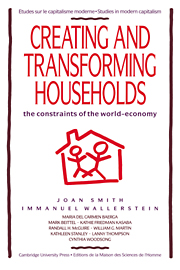Book contents
- Frontmatter
- Contents
- Preface
- I INTRODUCTION
- II THE UNITED STATES
- III MEXICO
- Introduction
- 1 Mexico City: the slow rise of wage-centered households
- 2 Central Mexico: the decline of subsistence and the rise of poverty
- IV SOUTHERN AFRICA
- V CONCLUSION
- A postscript on method
- References
- Index
- Studies in Modern Capitalism
1 - Mexico City: the slow rise of wage-centered households
Published online by Cambridge University Press: 07 June 2010
- Frontmatter
- Contents
- Preface
- I INTRODUCTION
- II THE UNITED STATES
- III MEXICO
- Introduction
- 1 Mexico City: the slow rise of wage-centered households
- 2 Central Mexico: the decline of subsistence and the rise of poverty
- IV SOUTHERN AFRICA
- V CONCLUSION
- A postscript on method
- References
- Index
- Studies in Modern Capitalism
Summary
Throughout the latter part of the nineteenth century, the workforce in Mexico City can be conveniently divided into three basic groups. First, there were the common laborers. They were employed as unskilled labor in workshops, as day labor on construction sites, and as factory operatives and outworkers. Secondly, there were the skilled artisans working for wages, who maintained a status somewhat higher than common laborers. Thirdly, there were those who offered goods and services in the marketplaces, in the streets and plazas. These were petty merchants and sellers of homemade products, and those offering personal services. Included among this group were the independent artisans who operated family workshops, or had been reduced to hawking their products on the street. During the 1890s, the demand for common labor of both genders increased, due primarily to the expansion of large-scale textile and tobacco manufacture, and to the boom in construction. The demand for skilled male laborers increased slightly. In contrast, opportunities for petty market activities were reduced as commerce came to be taken over by larger establishments and merchants.
Women made up better than one-third of the workforce in Mexico City from the middle of the eighteenth century to the beginning of the twentieth. Women were already quite active during the mid-nineteenth century in numerous occupations and trades, with domestic service representing only one-third of women's employment.
- Type
- Chapter
- Information
- Creating and Transforming HouseholdsThe Constraints of the World-Economy, pp. 150 - 169Publisher: Cambridge University PressPrint publication year: 1992



